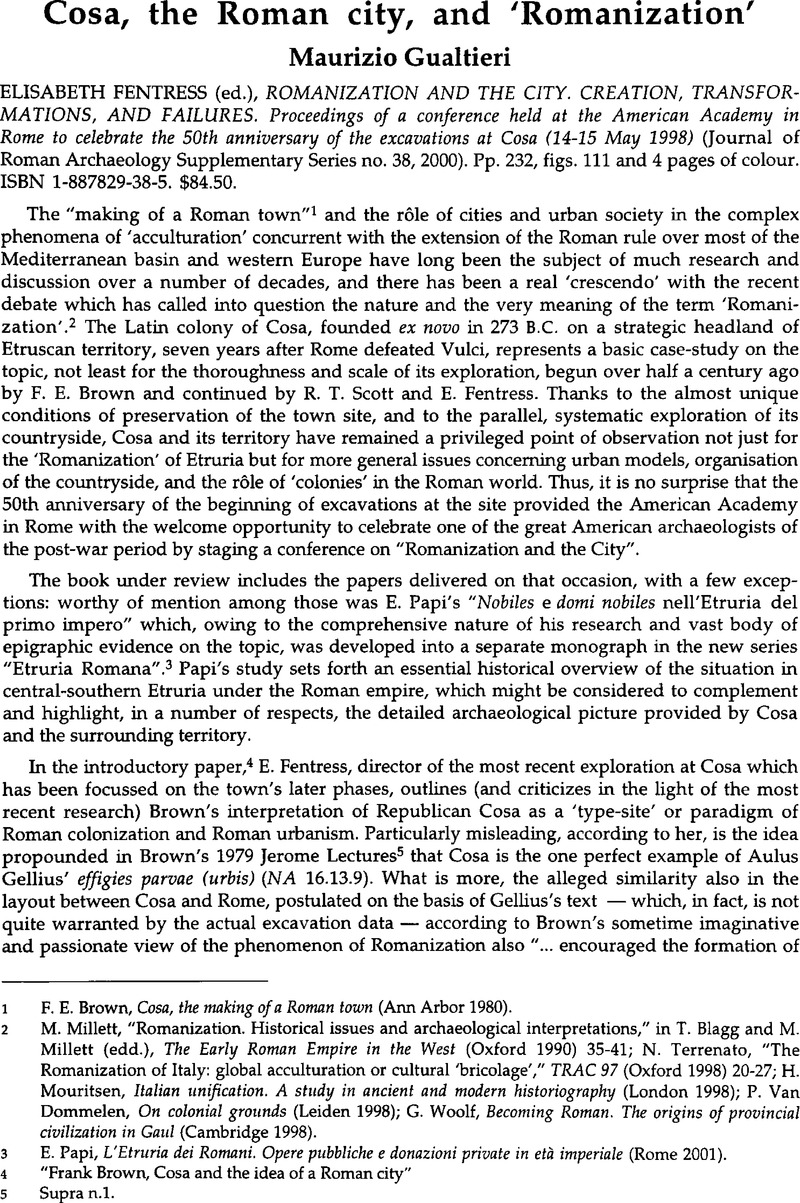No CrossRef data available.
Article contents
Cosa, the Roman city, and ‘Romanization’ - Elisabeth Fentress (ed.), ROMANIZATION AND THE CITY. CREATION, TRANSFORMATIONS, AND FAILURES. Proceedings of a conference held at the American Academy in Rome to celebrate the 50th anniversary of the excavations at Cosa (14–15 May 1998) (Journal of Roman Archaeology Supplementary Series no. 38, 2000). Pp. 232, figs. 111 and 4 pages of colour. ISBN 1-887829-38-5. $84.50.
Published online by Cambridge University Press: 16 February 2015
Abstract

- Type
- Reviews
- Information
- Copyright
- Copyright © Journal of Roman Archaeology L.L.C. 2002
References
1 Brown, F. E., Cosa, the making of a Roman town (Ann Arbor 1980)Google Scholar.
2 Millett, M., “Romanization. Historical issues and archaeological interpretations” in Blagg, T. and Millett, M. (edd.), The Early Roman Empire in the West (Oxford 1990) 35–41 Google Scholar; Terrenato, N., “The Romanization of Italy: global acculturation or cultural ‘bricolage’,” TRAC 97 (Oxford 1998) 20–27 Google Scholar; Mouritsen, H., Italian unification. A study in ancient and modern historiography (London 1998)Google Scholar; Van Dommelen, P., On colonial grounds (Leiden 1998)Google Scholar; Woolf, G., Becoming Roman. The origins of provincial civilization in Gaul (Cambridge 1998)CrossRefGoogle Scholar.
3 Papi, E., L'Etritria dei Romani. Opere pubbliche e donazioni private in età imperiale (Rome 2001)Google Scholar.
4 “Frank Brown, Cosa and the idea of a Roman city”
5 Supra n.1.
6 Brown, F. E., “Cosa I. History and topography,” MAAR 20 (1951) 5–113 Google Scholar; Brown, F. E., Richardson, E. H. and Richardson, L., Cosa II. The temples of the Arx (MAAR 26, 1960)Google Scholar; id. (supra n.1).
7 Here, P. Gros, “L'odèon dans la basilique: mutation des modèles ou désagrégation des programmes?”, is a case in point and an extremely interesting addition to the later history of both Cosa and Paestum.
8 See Torelli, M., “Edilizia pubblica in Italia centrale,” in Cebeillac-Gervasoni, M. (ed.), Les ‘bourgeoisies’ municipales italiennes au Ile et 1er siècles av. J.-C. (Paris-Naples 1983) 242–43Google Scholar.
9 Brown, F. E., Richardson, E. H. and Richardson, L., Cosa III. The buildings of the Forum (MAAR 37, 1993) 103–9 and fig. 40Google Scholar.
10 Welin, E., Studien zur Topographie des Forum Romamim (Lund 1953) 179–80Google Scholar.
11 See now Laurence, R., The roads of Roman Italy: mobility and cultural change (London 2001)Google Scholar.
12 Blake, E., “Constructing nuraghi: settlement and construction of ethnicity in Roman Sardinia,” TRAC 96 (Oxford 1997) 110–18Google Scholar.
13 Mastino, A., Analfabetismo e resistenza alla romanizzazione nelle barbaria sarda (I-IV secolo d.C.) (Sassari 1993)Google Scholar.
14 See Hingley, R., “Resistance and domination: social change in Roman Britain,” in Mattingly, D. J. (ed.), Dialogues in Roman imperialism (JRA Suppl. 23, 1997) 81–100 Google Scholar.
15 Alcock, S. (ed.), The Early Roman Empire in the East (Oxford 1997)Google Scholar.
16 See Webster, J. and Cooper, N. (edd.), Roman imperialism: post-colonial perspectives (Leicester 1996)Google Scholar.
17 See also F. Coarelli s.v. Praefectura urbana, in Steinby, M. (ed.), LTUR vol. 4, 159–60Google Scholar.




